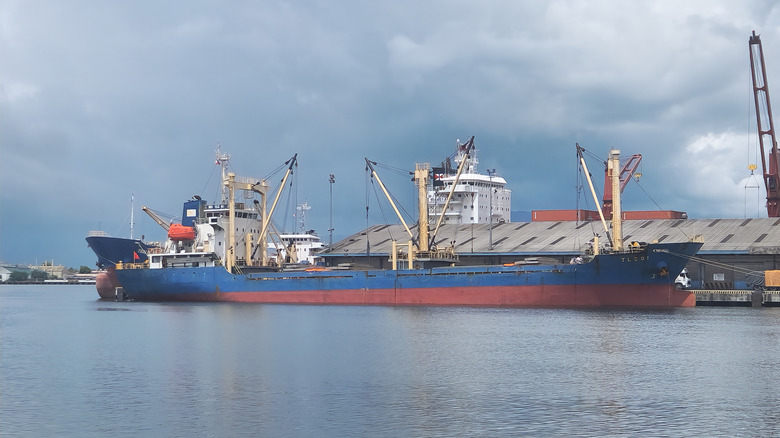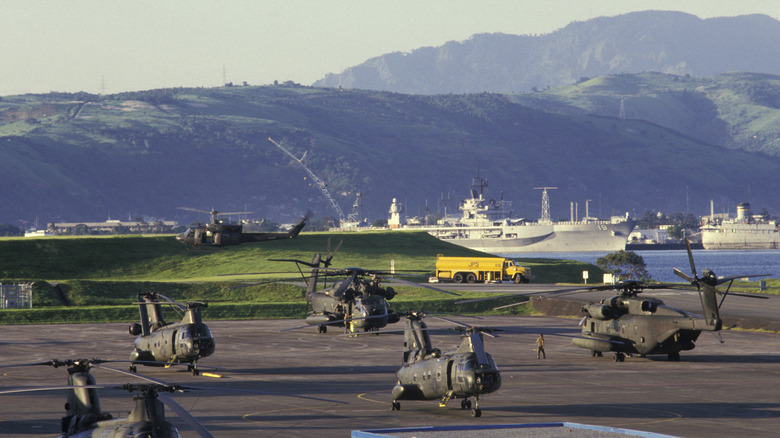The U.S. Is Weighing A Massive Weapons Hub Near China's Doorstep
The United States is weighing the creation of what could become the world's largest weapons manufacturing hub at Subic Bay in the Philippines, which was once one of the biggest American military bases in the world. It's sitting just 55 miles northwest of Manila and within striking distance of China. The plan surfaced after a June 2025 US House Appropriations Committee report directed the Pentagon, State Department, and International Development Finance Corporation to study the feasibility of a joint ammunition production and storage facility. President Donald Trump later called the project "very important," framing it as a way to boost US readiness while supporting the Philippines' own defense buildup.
For President Ferdinand Marcos Jr., the proposal ties into his government's Self-Reliant Defense Posture (SRDP), a program meant to reduce dependence on imports by developing local arms production. The Subic facility would reportedly produce explosives such as nitrocellulose and nitroglycerin and stockpiles for both US and Philippine use.
But the location is strategic first and foremost. Subic Bay sits just 1,100 kilometers from Shenzhen and Taipei, and 2,800 kilometers from Beijing, well within China's missile range. Since 2023, the Philippines has expanded US base access under EDCA and hosted advanced missile systems, shifting from rotational presence to a more permanent American foothold. If built, the hub would mark the most significant US defense investment in the Philippines since the Cold War.
Local pushback and fears of sovereignty loss
The proposal has already drawn sharp criticism inside the Philippines. The International Coalition for Human Rights in the Philippines (ICHRP) issued a statement condemning the plan as a direct assault on sovereignty, warning that the Philippines risks becoming a "staging ground for US wars in Asia." The group links the move to the broader US Indo-Pacific Ammunition Manufacturing Strategy, calling it part of Washington's military-industrial complex. Critics point out that Subic Bay was the site of massive anti-base protests in 1991 that led to the US withdrawal, only for plans of large-scale military use to return three decades later.
Fisherfolk group Pamalakaya echoed those concerns, warning that an ammunition factory would threaten both livelihoods and national security. Leaders cited risks of toxic chemical waste damaging fisheries, alongside fears that the Philippines could become a target in a US-China conflict. They argue the project undermines the hard-fought victory of removing US bases and opens the door to new displacement and environmental hazards.
Even the Subic Bay Metropolitan Authority (SBMA) has responded cautiously. While welcoming investment, officials noted that foreign equity in such ventures is capped under Philippine law, and flagged unresolved issues from community pushback and environmental compliance. SBMA has emphasized that talks are still exploratory and that most current US-run facilities in Subic are for logistics and humanitarian supplies, not weapons.
Balancing alliances, security, and domestic concerns
The Marcos administration has framed the project as a practical response to rising tensions with China in the South China Sea, which Manila refers to as the West Philippine Sea. Defense Secretary Gilberto Teodoro Jr. has signaled openness, citing the potential benefits of resilience, employment, and technology transfer, though he says no formal US proposal has yet been submitted.
At the same time, domestic pushback has complicated the narrative. Critics argue that growing US military presence, from nine EDCA sites to newly deployed missile systems like Typhoon and NMESIS, erodes sovereignty while raising the risk of retaliation from Beijing. Vice President Sara Duterte has also warned that aligning too closely with Washington could turn the Philippines into a "bullet shield for China."
Still, momentum appears to favor expansion. The US has already leased new warehouse space in Subic for prepositioning equipment, while its Marine Corps and Navy (one of the largest navies in the world) continue to increase their footprint across the region. Supporters highlight that the Philippines has a Mutual Defense Treaty with the US, and that co-production of ammunition could reduce reliance on imports while deterring external threats.
Whether the Subic plan becomes a permanent weapons hub or stalls under political pressure, its implications are clear. It is a test of how far Manila is willing to integrate with Washington's Indo-Pacific strategy, and how much risk it is prepared to accept, especially with China and its expanding naval presence.


